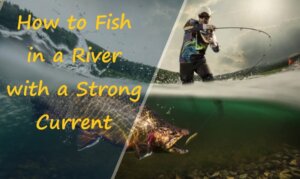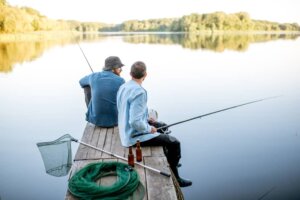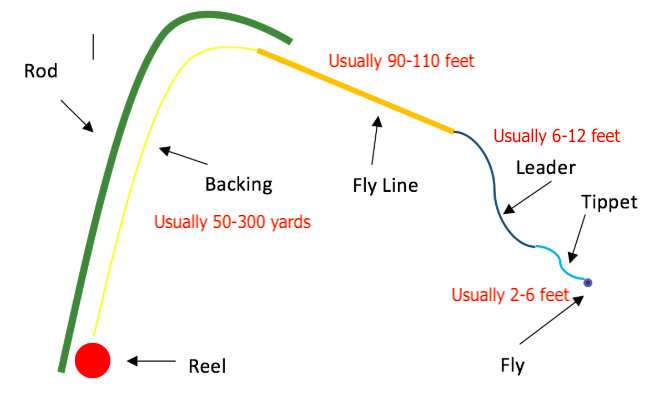
Have you ever lost a catch because of strong currents and wondered, ‘Do you know how to fish in a river with a strong current?’’ Well, this article is just for you.
It is well established that water bodies with strong currents flowing through them have some of the most diverse fishes that can be caught using basic fishing equipment.
However, fishing in regions with strong currents is extremely difficult for both beginners and professionals.
Currents are a fundamental part of the ecosystem that sustains all life on the planet. They are essentially strong underwater rapid flows that are caused by the internal heat of the water body.
The unique environment surrounding the water body causes strong currents to form within the water.
An example of a strong current water body is a river where the currents are high enough to damage sensitive fishing equipment.
Types of Fish in Strong Current Water Bodies
The best categories of fish are found at certain depths in rivers. Near the shoreline, the types of fish that are found are quite small.
However, the larger fish generally prefer to reside deep because they cannot swim in shallow waters.
At these depths, the combination of high pressure and temperature causes the formation of strong currents.
These currents are streamlined regions of water moving at high speed and surrounded by semi-steady or slow-moving water.
Why is Fishing in the Strong Current Difficult?
Currents are underwater streams. This means that whenever a fishing line casts out bait at a depth, the current might resist the baitcasting reel’s pull if a large fish is hooked onto it.
The current might end up removing the hook from the fish altogether, resulting in a lost catch.
Due to this phenomenon, it is extremely challenging to catch fish in strong currents, even with a ton of experience.
Requirements for Fishing in Strong Currents

Fishing in strong currents is not only physically taxing, but it requires determination to counter the pull of both the fish and the current when a fish gets hooked onto the line.
To ensure that your equipment does not fail you, you need to get individual components of a bait caster and assemble it yourself.
This way, you can get the best version of each component and make a quality baitcasting rod that can handle strong current forces.
The primary components of any baitcasting fishing equipment are stated below:
- Baitcasting reel
- Fishing line
- Fishing rod
- Hooks
Best Components for Fishing in Strong Currents
Baitcasting Reel
A baitcasting reel is essentially a complete integrated system used to pull out the fish when snagged onto the hook. It is the primary driving component of any fishing equipment.
The quality of a baitcasting reel directly corresponds to your ability to fish in high-speed underwater currents.
Here are a few features that are necessary for a baitcasting reel when designing a quality fishing system that can withstand the pull of high-speed currents.
Durability
A baitcasting reel should be highly durable if it is to be used to pull out a fish that is trapped within the pull of a current.
Normally, a good baitcasting reel is made of a rigid material such as aluminum or any other metal.
These materials can provide significant assistance in pulling out a fish from a strong current without sacrificing the structural integrity of the entire system.
Endurance
Fishing in strong currents requires time and patience. Even after a line is hooked, the baitcasting reel can experience high pressure for a long time from the pull.
A quality baitcasting reel is needed, which can withstand the intense pressure over a long period. It does not fail on itself or any other component within the fishing system.
Performance
Every baitcasting reel’s main function is to help the user reel in the fishing line once it has snagged a fish on the hook.
The complex gear-pulley system within the reel is attached to a knob. The user rotates this knob clockwise to pull the fishing line from the water and catch the fish.
In strong currents, it is necessary to have many ball bearings to support the gear-pulley system. A ball bearing is used to put space between the axis line and the load.
The number of ball bearings inside a baitcasting reel directly relates to the reel’s ability to withstand high-pressure situations such as strong current pulls.
A quality baitcasting reel can be made of either metal or a strong, rigid carbon metal for optimum performance when fishing in strong current water bodies.
Such baitcasting reels can be acquired at an affordable cost from Amazon.com.
Extra features such as reverse ball bearing and line stoppers are also useful for fishing in strong currents.
Fishing line
The fish are found in deep waters where strong currents are generally large and weigh a lot more than other fish found in shallow waters.
For this reason, it is good practice to utilize a multi-stranded fishing line that can support up to 60 to 80 pounds of weight.
There are two types of multi-stranded implementations of fishing lines that are capable of supporting the back force applied by the fish and the current.
Thermal fishing lines
This fishing line consists of multiple filaments bonded together using high-energy chemical reactions that fuse the filaments into a single multi-stranded fishing line.
This final fishing line can support the desired force output from a fish swimming in water bodies with a strong underwater current.
Braided Fishing Lines
Braiding fishing lines is basically what its name implies. It uses the common method of braiding fishing lines to form a single line containing multiple filaments.
This way, if a single filament fails, the fishing line remains intact and does not fail immediately.
Either of the two multi-stranded fishing lines will suffice for fishing in strong currents.
It is best to reel in a lengthy line when setting up the fishing equipment since, this way, you can have some wiggle room when your bait gets hooked.
Fishing Rods
Every other fishing equipment component is always attached to the fishing rod. From the baitcasting reel to the fishing line, all depend on the structural integrity of this piece.
The durability of the fishing rod is what keeps the entire fishing equipment from falling apart.
If your fishing rod cannot handle the extreme pressure of the currents, then it might snap, and you might lose your equipment as well as the fish you had hooked onto the line.
There are many types of fishing rods capable of withstanding the forces of a high-speed underwater current. They are either made of metal or a strong carbon material.
Metal rods
Metal rods are the traditional implementation of fishing rods. Their high structural resilience under prolonged pressure is what is needed for fishing in high-speed currents.
The rod has small rings attached to it along its length. These rings are guides for the fishing line and help pull the fish out of water.
Carbon rods
Carbon rods are a relatively new version of strong fishing rods. They have the durability that is seen in metal but is lightweight compared to their metallic counterparts.
This gives the user an advantage since a heavy rod might offset the structure’s balance and result in the user losing control.
Any loss of control of the rod when reeling the fish in might cause it to slip from your hand and fall into the water, which will then be a bit difficult to retrieve.
A quality fishing rod can be found on Amazon.com within a couple of hundred dollars, supporting the strong current’s high pressure.
Hooks
A high-quality hook is the most important component of any fishing equipment. There is a high chance that the hook might bend or break if too much force is applied in strong currents.
This is why a quality fishing hook is necessary since a fish can be tired after a while, but it is most likely lost forever if it escapes from the hook.
Assembling Fishing Equipment for Strong Currents
After getting all the components for fishing in strong currents, you can assemble them by going through the following steps:
- Take your fishing line and reel it into the bait caster. Use at least 12-15 meters of line to accommodate the extras you might need when fishing in strong currents.
- Attach the baitcasting reel onto the fishing rod.
- Take the reeled-in a fishing line from the bait caster and guide it through the fishing line’s rings. After the final ring, let the fishing line dangle with about 1-2 meters.
- Now attach the fishing hook onto the line, and tie a knot on it.
- Attach the bait on the hook.
The Best Area to Set Up Fishing Line

The best area for casting a fishing line will be out in relatively deep waters. In these areas, people can find the best categories of fish that are often viewed as trophies.
The best way to reach the deep waters is to use a small boat or kayak to get there.
Boat
A boat can get you to deep waters, and you can set up your equipment on either side. Be careful on the boat since the strong currents might pull on the line, and it might wobble from side to side, which could cause motion sickness.
Kayak
Many companies around the world develop quality kayaks that are custom made for fishing in strong current areas. These kayaks are designed to counter the wobbly movements caused by the currents and when force is applied to the line.
A kayak has multiple attachment points on either side where fishing rods can be set as the user waits for the line to get snagged.
A kayak is the best way to reach the locations where deep water fish reside and strong currents are found.
How to Reel in Fish From Strong Currents?
The most challenging process when fishing in a strong current is the difficulty of reeling in fish.
Any misstep can result in a catastrophic equipment failure and permanently damage the bait caster components.
If you pull on the reel too hard, then you risk snapping the fishing line or breaking the fishing rod itself.
Certain precautions must be taken to ensure that you do not put your equipment at risk of permanent damage.
These precautionary steps are defined below. Each of these steps considers the different situations you might face when fishing in high-speed currents:
- Once your fishing line starts to pull on the reel, avoid taking any quick action. Rather, you should let the fish swim out of the strong current itself and then reel it in easily.
- If the fish cannot escape the high-speed underwater current for some reason, you need to guide the fishing line slowly. Do not pull on the knob too hard. Use the fishing rod to manoeuver the fish away from the area of the strong current.
- Release the fishing line a little and let the fish swim slightly further if it can. This way, you do not have to deal with the strong pull of the underwater currents.
- Your catch can get trapped in the current. To counter this, you need to rotate the knob on the reel while at the same time pulling on the rod. Do these steps in small sets such that your line does not experience too much force. Otherwise, it might snap, and you could lose your catch.
